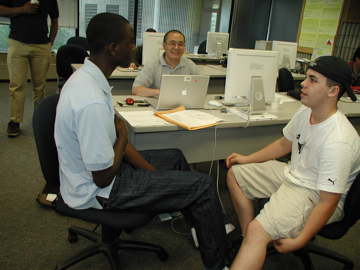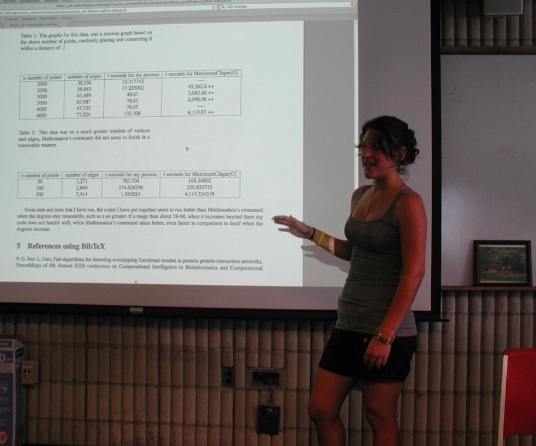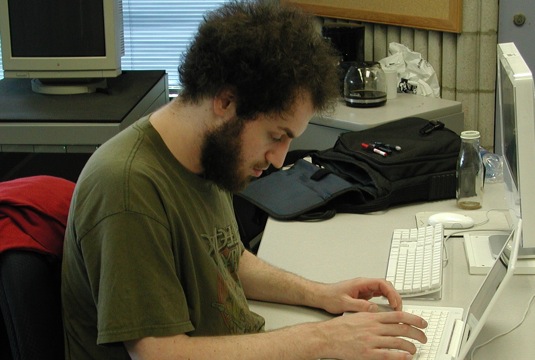Kool math kids
Posted by: Gary Ernest Davis on: September 6, 2010
I am writing this post as a result of a prompt, a nudge, from some Tweeps, who wrote: “Why does our country often portray math enthusiasts as uncool? Discuss” with a link to:Â “Why is it that other countries celebrate math and science while we often portray them as ‘uncool’?”
This resonated with me because for several semesters now I have been deeply engaged with some seriously cool mathematics undergraduates. I realize, of course, that “cool” is a subjective term [understood deeply only by cool people :)] so in the interests of quasi-scientific research (= your opinons) I want to present you with some really cool mathematics kids, and ask for your feedback on how cool you think they are.
The students I want to present to you, along with some of their cool interests, are all undergraduates at the University of Massachusetts Dartmouth. They all are, or have been, participants in a National Science Foundation funded project designed to stimulate interest in computational science.
Sidafa Conde and Zachary Grant
Sidafa is a mathematics and business major, and Zach is a mathematics major. These two undergraduates work together on Fourier analysis and Fourier approximation of functions.
Sidafa spent Summer 2010 working with a group of undergraduates on Enabling Physiologically Representative Simulations of Pancreatic Beta Cells at the University of Maryland BC Â on the Interdisciplinary Program on High Performance Computing. Sidafa said to me when he returned to Dartmouth MA that other students at UMBC wondered how he knew so much about advanced topics. The answer lies in the stimulating and fun atmosphere that we promote in our program for these enthusiastic students.
Zach spent the Summer working on a research project with his mentor Professor Sigal Gottlieb, and presented a talk on his research – Adaptive Hybrid Trigonometric Polynomial Reconstructions [grant_siam2010presentation]-Â at the annual conference of the Society for Industrial and Applied Mathematics in Pittsburgh. At that talk a professor of mathematics from another university asked Zach to consider applying for graduate school there. Zach was then a sophomore so he had to respectfully decline. Zach’s work with Sigal Gottlieb will likely lead to a significant publication soon.
Sidafa and Zach have presented talks or posters together, and with other undergraduate students, at  Sigma Xi Research Exhibitions, the Mathematical Association of America regional meetings, and at the Massachusetts Statewide Undergraduate Research Conference.
Sidafa and Zach are exceptionally kool math students who we hope will, this Fall semester, go and talk to high school students about their love, passion and achievements in computational mathematics.
Leanne Silvia
Leanne Silvia began as a honors student in our undergraduate computational science program when she was a freshman. This Fall, as a beginning junior she will be presenting her research at the Wolfram Technology Conference in Champagne, IL.
Leanne’s current research project [lsilvia_siam2010poster] – not her first! – Â is devising improved algorithms for finding cliques in simple graphs. The clique problem is NP complete, so if then there is no fast algorithm to solve this problem. Mathematica has in-built algorithms (in Combanitorica) to find maximal cliques. Leanne’s algorithm finds all cliques, and over a certain size of graph, does it faster than existing Mathematica algorithms.
Leanne came to this problem as a result of being in an upper level course on modeling protein-protein interactions. Her algorithm may prove to be especially useful to biologists working in this area.
I think Leanne is one really kool math kid.
Chris Bresten
Chris entered the University of Massachusetts Dartmouth as an honors freshman student. In his freshman year he worked with his adviser Professor Jae-Hun Jung, now at SUNY Buffalo, on the rate of convergence of a parameterized family of quadratic maps to fixed points. This original work has since been published [C. L. Bresten and J.-H. Jung, A study on the numerical convergence of the discrete logistic map, Nonlinear Sciences and Numerical Simulations,14,pp. 3076-3088, 2009.]
Chris has worked on a range of research topics, including cryptography [cbcrypto], random noise generators & image processing.
Chris is now a graduate student in the Department of Mathematics at SUNY Buffalo.
Chris is, and will forever remain, one of the koolest math kids I have had the privilege of knowing.
Adelaide Hopkins
Adelaide is an exceptionally kool math student.
She graduated in 2010, and as an honors student worked on computational aspects of detecting terrorist networks [ahopkins_report].
Adelaide was a mathematics major and became passionately interested in Middle East politics, and terrorist networks in particular. We talked about how she could marry these interests and she came up with a project with her mathematics adviser, Professor Dana Fine, to explore computationally the aspects of terrorist networks.
Adelaide’s research is a fine example of how following one’s passions, however far apart they seem, with appropriate mentoring, can lead to exceptionally cool research.
Adelaide is a gem and a truly kool math kid.
_____________________________________________________________________________________________________________
We have the pleasure of working with these , and other, exceptionally talented passionate students. We mentor them to follow their interests, to talk in class, to present posters and talks at conferences, and to make a difference in the world. Â That’s kool!
4 Responses to "Kool math kids"
[…] Kool math kids « Republic of Mathematics […]
Good point, though sometimes it’s hard to arrive to definite conclusions





October 25, 2010 at 3:38 pm
lil upset i’m not one of these kool kids
October 26, 2010 at 7:40 am
Hilary B. Burnham, you are indeed kool! The students highlighted were, or are, part of CSUMS. Write me (urgetocompute(at)gmail.com) with what you are doing now, and what’s great about it, and I will write a post about you. I look forward to it.